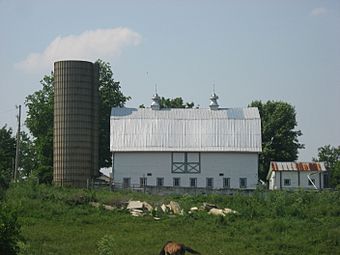McDonald Farm (Xenia, Ohio) facts for kids
Quick facts for kids |
|
|
McDonald Farm
|
|

A silo and barn at the farm
|
|
| Location | 1418 Stone Rd., Xenia, Ohio |
|---|---|
| Area | 68 acres (28 ha) |
| Built | 1829 |
| Architectural style | Federal, Greek Revival, I-house |
| NRHP reference No. | 96000673 |
| Added to NRHP | June 14, 1996 |
The McDonald Farm is a special old farm near Xenia, Ohio. It's known as a historic site because of its history and a unique stone quarry. This quarry provided stone for a very famous landmark: the Washington Monument!
The Farm's Special Stone Quarry
Much of the land in Greene County, Ohio, has a type of high-quality rock called limestone. This special limestone is found deep underground. Farmers in the 1800s often used this stone for building. By the late 1870s, this stone was even sent to faraway places by train.
Wilford McDonald lived near Xenia. Around 1820, he started digging limestone from his farm. A small stream helped expose the stone. He found limestone deposits up to 8 feet deep in some spots. Much of this stone was smoothed by ancient glaciers.
McDonald's quarry became very famous. It was known as the best source of limestone in Greene County. Before concrete became popular, McDonald supplied a lot of stone for buildings in Xenia. Some of his stone even traveled to other towns. Eventually, McDonald's quarry was known for having one of Ohio's best limestones.
Quarrying continued until 1896. A flood from the nearby stream filled the quarry with water. A small amount of stone was dug in the 1930s, but the quarry is now filled with water.
A Piece of History: The Washington Monument Stone
In 1849, each state in the United States was asked to provide a block of stone. These stones would be used to help build the Washington Monument in Washington, D.C.
Because McDonald's quarry was known for its excellent limestone, Ohio's geologists chose a block from his farm. A stone worker from Xenia cut a block of stone. It measured about 6 feet long, 3 feet wide, and 0.75 feet thick. This special stone was sent to Washington, D.C. Today, you can find it inside the monument's stairway.
McDonald Farm: A Historic Place
In 1996, the McDonald Farm was added to the National Register of Historic Places. This is a list of important historic sites in the United States. The farm was recognized for two main reasons. First, its farm buildings show different types of architecture. Second, the farm played an important role in local history.
The farm buildings have a mix of styles. These include a simple I-house and more formal styles like Federal and Greek Revival. The historic part of the farm covers 68 acres. It includes nine buildings and two other important spots. This whole area is called a historic district.



